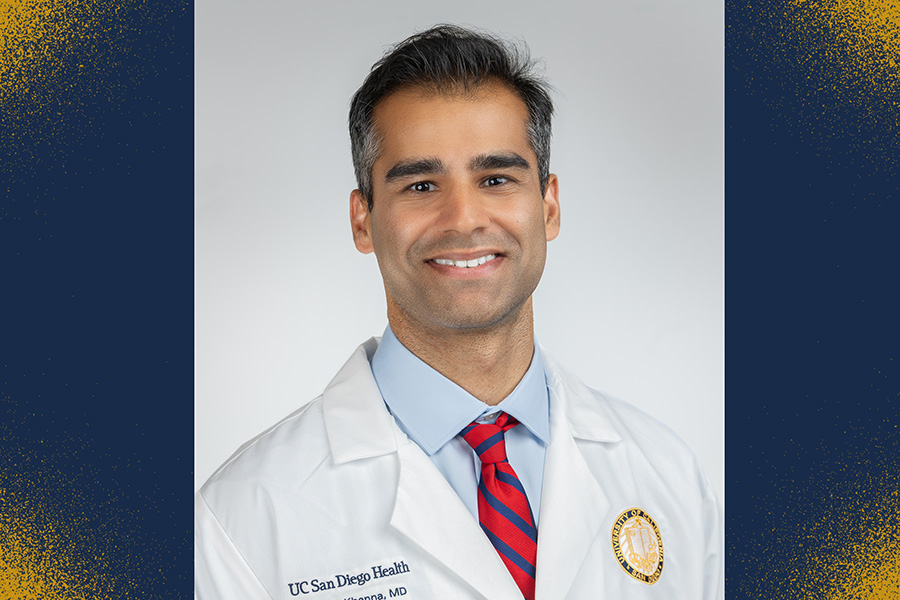
Dr. Khanna, our newest assistant professor of neurological surgery, shares how he is dedicated to exploring groundbreaking techniques, enhancing surgical practices, and fostering a culture of interdisciplinary collaboration at UCSD.
Meet neurosurgeon Dr. Arjun Khanna
We caught up with Arjun Khanna, MD, our newest assistant professor of neurological surgery at UC San Diego Health, to learn about his passion for growth and innovation in the field and his plans for leveraging our collaborative environment to advance neurosurgery and patient outcomes.
Interviewing Dr. Khanna
What motivated you to join our team, and what aspects of our institution attracted you the most?
The entire UC San Diego Neurosurgery Department is known for pure excellence in neurosurgery. It's a dynamic, diverse, and talented team. As an early career neurosurgeon, I am enthusiastic about working among colleagues from whom I can continue to learn and grow as a clinician.
During my conversations with Drs. Alexander Khalessi, Sharona Ben-Haim, and the rest of the team when I applied, it was clear from day one that the institution and department are excited about growth and innovation – to both expand access to more patients in our community, and to push the field forward through research and innovation. I’m excited to be a part of such a dynamic, growth-oriented environment at UCSD.
What specific areas within neurosurgery are you most passionate about?
One of the areas I'm particularly passionate about is being able to use techniques in functional neurosurgery to understand at a more fundamental level the disruptions in neural circuitry that occur in a wide variety of neurologic disorders, and then to use this knowledge to develop new ways of treating these diseases. That incredible synergy -- of investigating the basic neuroscience of neurological diseases we see in clinic, and to use those findings to develop new and personalized treatment strategies – represents an exciting and promising paradigm of precision clinical neuroscience.
This approach has led to a shift in our understanding of epilepsy in particular, the appreciation of epilepsy as a network disease, which has led to the development of novel treatments like deep brain stimulation or responsive neurostimulation that are targeted toward network neuromodulation. This is an area I'm extremely excited to explore – a new way of thinking about the role of surgery in the treatment of epilepsy that has opened up exciting new avenues for research, and enables us to provide new treatment options for patients not previously considered to be surgical candidates.
Can you discuss any groundbreaking surgical techniques or technologies you plan to explore further at UCSD?
One emerging concept in functional neurosurgery is a greater appreciation for the role of the thalamus and thalamocortical networks in many neurological disorders, including epilepsy, movement disorders, and pain syndromes. Although the thalamus has historically been difficult to study or treat, recent advances in neuroimaging, surgical technologies, and medical devices have enabled unprecedented insight into the role of this critical structure in brain function and dysfunction. A prominent theme of my training at MGH and Stanford has been to harness the tools at our disposal in functional neurosurgery to more rigorously explore and modulate the thalamus for the treatment of these disorders. This is an area ripe for future study and innovation, and I am excited to continue this line of work at UCSD.
How do you anticipate leveraging the collaborative research environment to advance your research objectives and improve patient outcomes?
UCSD has a trifecta of an incredible neurosurgery department, powerhouse basic neurosciences, and a world-class engineering school. One key aspiration of mine is to make the clinical opportunities, technologies, data, and analytical tools as open and accessible as possible to co-investigators and students anywhere in the UCSD system. Neurosurgeons regularly interact with one of nature’s most mysterious creations; I am thrilled to invite the broader UCSD community to participate in our endeavors to understand and treat it.
I am also excited to work with our colleagues in the Jacobs School of Engineering to develop and deploy the next generation of implantable neural devices. I believe device-based clinical diagnostics and therapeutics represent an exciting growth area in clinical neurosciences – and I am looking forward to collaborations aimed toward realizing that future.
What do you hope to achieve personally and professionally here?
Ultimately, my fundamental motivation is the safe and effective care of patients. My primary objective is to establish the highest quality and safest neurosurgical care possible for patients at UCSD.
I also aspire to harness the resources at UCSD to contribute toward making neurosurgical care better, whether it's improving on current techniques, inventing new technology, or enhancing our fundamental understanding of these disease processes to be able to spur further innovation.
How do you envision your role contributing to the broader mission and goals of UC San Diego Health?
It is an exciting time to be a functional neurosurgeon. Incredible recent advances in surgical technologies, basic neurosciences, and bioengineering together are enabling breakthroughs in our ability to diagnose, understand, and treat an ever-increasing array of neurological disorders. I am excited to work toward this future at UCSD. I view it as a central prerogative of my role to make this dynamic field as accessible as possible to any and all clinicians, students, and academics at UCSD who are interested in working together to improve the lives of our patients.
